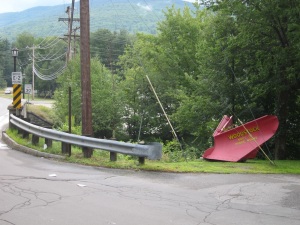 If you can swing it, come in from the north. Shooting down the highway, eye-opening mountains and “notches” rising on either side, angry and dark clouds massed above and ahead as if ready to pounce or knock you into nonexistence with a nonchalant flick of a paw – you then quickly exit the fast road and empty into the small, slow town.
If you can swing it, come in from the north. Shooting down the highway, eye-opening mountains and “notches” rising on either side, angry and dark clouds massed above and ahead as if ready to pounce or knock you into nonexistence with a nonchalant flick of a paw – you then quickly exit the fast road and empty into the small, slow town.
As with our last stop on this thematic tour – Connecticut’s Woodstock – were it not for the signs informing you that you were someplace special, you would not know you were anyplace in particular. For us, placeness is a compelling concept, and the search for and luxuriating in locations that exude it are part of our life’s work, so to be here was to experience a sensation as if standing out in a field while holding a Geiger counter and not picking up a single click.
This Woodstock is a traveler’s draw, a crossroads, a spot for White Mountains tourists to stay a night or two, and/or find a place to eat familiar food on the way between here and there, in the center of beauty if not beautiful itself. Being that there are only a little over a thousand permanent residents spread over nearly 60 square miles, the tourists in season easily outnumber the locals, but the locals, who operate b&bs and run or work in the restaurants and shops, are happy to be overrun. It is not, however, really Woodstock that is the center of activity, but rather the contiguous North Woodstock, which, confusingly, suddenly changes into Lincoln before you can apply the brakes. There are lovely and old parts of the town – is it Woodstock? North Woodstock? – like the Soldiers Park, with its memorials to the area’s fallen in various wars, and longstanding classic-form churches, even the huge snowplow with the town’s name on it that serves as the welcome sign, all informing us of the centuries’-old American values of the place: what was important, what was held dear, what constitute the acknowledged and accepted cycles of life. These are the spots in town, few and far between now, that feel most like the classic New England village, that resonate with, if not placeness, then certainly a heartfelt and long-held identity. But it is up the road a piece where most of the visitors are, where things widen out, parking lots spread from the expanding road, boxy commercial buildings have opened up shop, where a once vital train line is now a short-haul theme restaurant, and a new kind of American value is honored.
Oh, and there are, along this stretch, tours that guarantee, for a price, that you will see a moose. Given that moose are notoriously shy creatures, and that they tend to stand in the leafy groves beside roadways, in the shadows, it seems peculiar that a jaunt to see them would, first, take place at an evening hour when all is dark and, second, that there could be a guarantee. When we ask an employee of the company how they can be so certain that moose will be spied, that person replies that the little vehicles with paying customers inside go toodling off to where they know moose often can be found and then throw high-intensity spotlight beams into the forest, catching a poor moose unawares and scaring the bejesus out of it. Had much of their habitat not been cleared away and paved over, moose would be all over the place, and you’d need a bus to go somewhere where you could not see them. (As it happened, we missed the tour, saved our money, and the next day, as we made our way to the next state and the next Woodstock, we saw a moose by the side of the road, staring at it as it looked, disinterested, back at us, and not one watt of artificial light was required for this meeting of the minds. The joy of seeing it was greater because serendipity was involved. Sometimes the old ways of doing things are best.
Next stop: Woodstock, Vermont.




















